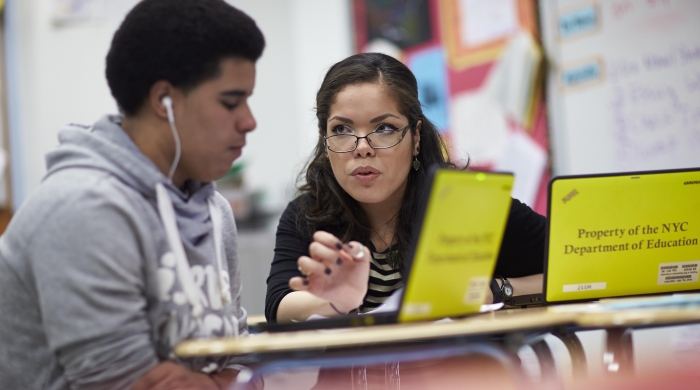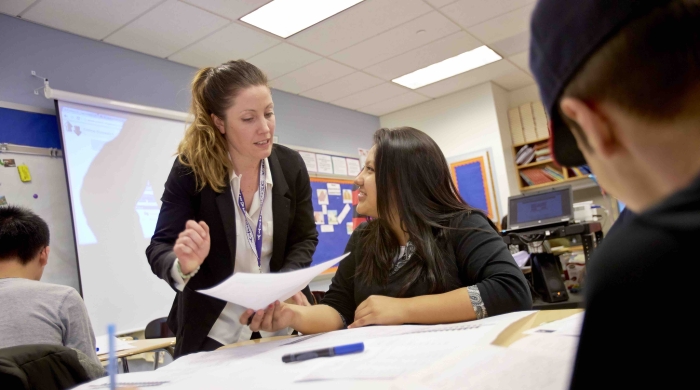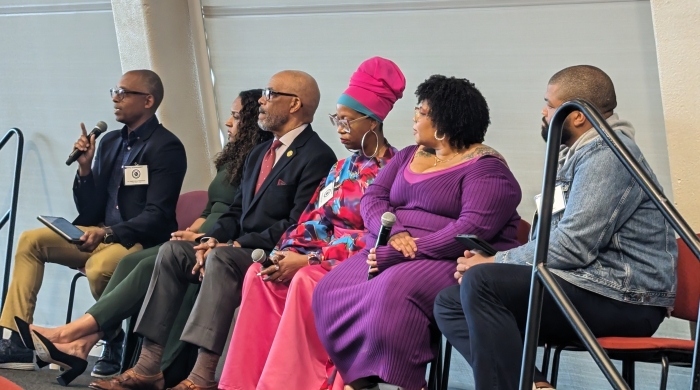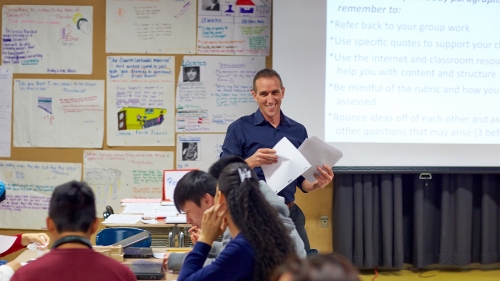Assistant Professor of Teaching and Learning at NYU Steinhardt Shamari Reid asks teachers to surrender their superhero capes in his new book on love, justice, and liberation in schools.
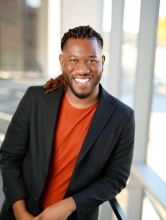
Teachers in the U.S. have long fulfilled many roles – educator, arbitrator, counselor, psychologist, tutor, politician, and cheerleader, among others – that can feel thankless, given the job’s long hours, stressful working conditions, and stagnant salaries. Additionally, a slew of new laws restricting what teachers can say about race, history, and LGBTQ+ issues has brought confusion and the threat of professional, social, and legal consequences to classroom discussions.
What’s a teacher to do? In the face of these challenges, Assistant Professor of Teaching and Learning Shamari Reid, whose work focuses on creating equitable opportunities in schools, is asking those in the profession to remember that they are people first.
In a new book, Humans Who Teach: A Guide to Centering Love, Justice, and Liberation in Schools, Reid reflects on his life and experiences teaching elementary, middle, and high school students, and the lessons he has learned about safeguarding personal well-being, protecting students, and teaching in a climate of fear.
“I was socialized to believe that my pedagogy was going to rescue my Black students and students experiencing poverty from racism, classism, and other social ills. I was no longer human; I was a teacher,” Reid writes of the outsized expectations that are often placed on teachers’ shoulders.
Throughout Reid’s book are exercises including an “identity pie” to help teachers sort through the identities they think about most (e.g., race, age, sexuality), a chart to calculate how much time is allocated on teaching-related tasks during and outside of work hours, and prompts to explore how one’s teaching promotes the growth of students and responds to their challenges.
He asks teachers to remind themselves that they are humans, with needs, limitations, and possibilities – and that helping students reach their potential is difficult when you aren't at your best. Writes Reid, “If even just one of us weren’t here, the whole world would shift. So, we must take care of ourselves, as we cannot be replaced.”
Here are some lessons from Reid’s book about self-care, teaching with love, and persisting through challenging times.

On Love of Self
“For me, an overwhelming work week was not the only evidence that I was out of balance. I noticed upon reflection that I often skipped lunch, did not drink enough water throughout the day, and did not have enough moments to breathe and process.”
For Reid, a diagnosis of exhaustion after inexplicable symptoms led him to focus more on his well-being and to encourage others to do the same. He emphasizes the need to care for one’s physical well-being (e.g., sleep, nutrition, hygiene, exercise); emotional well-being (therapy, breathing exercises, and journaling) and spiritual well-being (pursuing activities that spark joy, whether it’s listening to Mariah Carey or preparing a comforting meal).
“Cultivating a healthy sense of self-regard and attending to my overall well-being made me not only a much more joyful and peaceful human, but a much more effective human who teaches.”
On Teaching with Love
“Once you learn about challenges and circumstances students and their communities are navigating, then you can use your teaching to respond to the things that complicate their lives and threaten their growth and overall well-being. This is how your class can become a place where you and your students can partner to tackle some of the challenges they are facing.”
Reid suggests finding ways to let students bring their experiences and lives to the classroom, and being cognizant of their well-being. In his classrooms, he has invited students to share more about themselves and their world through activities such as icebreakers and journaling. One popular activity among students was an assignment to create album covers and track lists based on their lives.
Additionally, Reid implores teachers to speak up when students face mistreatment from classmates, colleagues, parents, or administrators. “Love moves us to stand up against and call out corrupt coworkers, administrators, schools, school boards, parents, politicians…and ourselves when we, too, make mistakes.”
On Conquering Fear
“[Many] of us are working within states, districts, and schools in which there are limitations on the kind of content we can share with our students. These limitations range from content that accurately depicts our shared racialized history to content that affirms LGBTQ+ identity. So we have a choice. We can choose to engage anyway, or we can give in to fear and choose to be inactive. And if we choose to remain inactive and refrain from interrupting, too many students will continue to suffer.”
Reid suggests identifying what you are afraid to do, envisioning the goal or outcome, and breaking the larger goal into realistic, daily steps.
He shares a time years ago when he wanted to incorporate multimodality – the use of a wide variety of mediums – into his classroom, but was simultaneously overwhelmed at the new challenge.
“Once I learned that my classroom was limiting students’ growth by not embracing multimodality, I let go of some of my hard-earned initial ideas about teaching…My students’ growth required that I transform my teaching practice.” He started small, inviting students to share ideas outside of traditional print and began to expand its use in full class sessions.
On Disrupting the Status Quo
“[We] perpetuate the status quo by remaining silent or inactive about issues of marginalization, refusing to interrupt injustice, staying uninformed about the challenges students and their communities face, not committing to our own unlearning, not calling in folks in our lives on their oppressive beliefs and actions, electing bigot politicians, teaching revisionist history, refusing to center counternarratives in our curricula, and many more things that maintain oppression and marginalization.”
Reid says that the ways teaching can disrupt the status quo varies widely and he shares suggestions that he and his colleagues have used in their schools. These include attending an anti-racist book club with other educators, incorporating more stories of minoritized communities experiencing joy into curricula, class walks focused on learning local history, letter-writing campaigns to public officials, and scheduling conversations with students’ families or guardians to learn more about their history.
Related Articles
Steinhardt’s Teacher Residency Program to Benefit from $12M Grant
NYC Public Schools has received a $12M grant to support incoming teachers in high-need schools.
How Likely are English Learners to Graduate from High School? New Study Shows It Depends on Race, Gender, and Income
Analysis of four-year graduation rates of English learners shows influence of individual characteristics.
Metro Center Hosts Equity Now: 70 Years of Brown vs. Board Conference
NYU Steinhardt’s Metro Center hosted the Equity Now Conference exactly 70 years to the day since the momentous Brown vs. Board decision.
Related Programs
Related Department
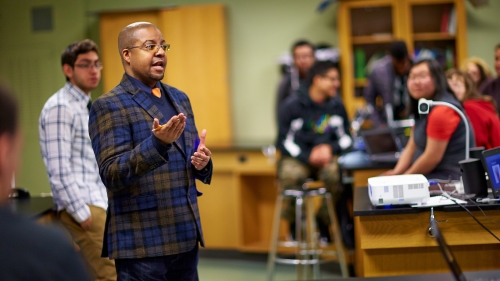
Teaching and Learning
Department of Teaching and Learning
239 Greene Street, Sixth Floor
New York, NY 10003
Tel: 212 998 5460

